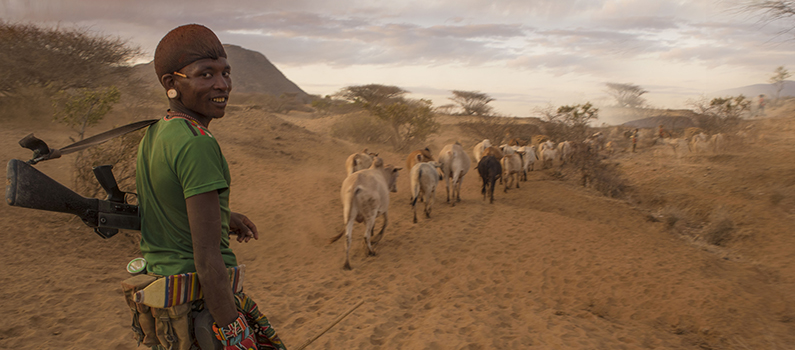Season 1

“Water to Dust” explores the threat faced by Africa’s largest desert lake, Lake Turkana. Its principal water source, the Omo River, has been dammed in neighbouring Ethiopia. If the lake dries up, hundreds of thousands of Kenyans will lose their livelihoods as fishermen. Cattle grazing, previously the main activity of pastoral tribes in the region, is now impossible because of spreading deserts and climate change. Will Kenya allow another Aral Sea disaster to happen?
A film by Narissa Allibhai & Mitchelle Jangara
Lake Victoria is Africa’s largest lake, but an ecological disaster threatens the lake’s future and the 35 million people who depend on its bounty. The lake has seen the largest losses of biodiversity ever recorded. 300 native fish species have been wiped out by invasive species and overfishing. An ambitious three country-wide team reports on Lake Victoria’s environmental crisis.
A film by Benj Binks
Part 2 of Ziwa Victoria documents unsound environmental practices along the Great Lake’s shoreline: the replacement of indigenous rainforests with palm oil plantations, artisanal gold mines that leach mercury, uncontrolled use of pesticides and sewage pollution. They all contribute to oxygen depletion and the spread of water hyacinth choking the lake. The film also looks at possible solutions to save Africa’s greatest lake.
A film by Benj Binks
Lake Naivasha has the largest population of African fish eagles in the world, despite that fact that Naivasha city has grown to a million people and hosts one of the main export earners of Kenya – the flower industry. Although the lake is under severe pressure a Kenyan born raptor scientist Dr Munir Virani tries to explain why the eagles are doing so well and how to save their precious home.
A film by Munir Virani & Kiran Ghadge
Part 2 of Fish Eagles continues to document the threats faced by Lake Naivasha from invasive species introduced into the lake. The film also profiles the people working to find a solution to the lake’s environmental crisis.
A film by Munir Virani & Kiran Ghadge
Kenya’s most famous TV investigative reporter produced a four-part film on the cattle wars in northern Kenya. In the lawless wilderness of northern Kenya, where pastoralists graze their cows, well-armed herders are forced to compete for diminishing grasslands in this era of climate change. Cattle rustling between Samburu, Boran, Pokot & Turkana warriors is on the rise. Hundreds have died in senseless cattle wars that top Kenya’s losses from terrorism.
A film by Sam Munia and John-Allan Namu
In the second part of “End of the River” John-Allan Namu documents how a severe drought has impacted Kenya’s northern rangelands. Competing tribesmen have attacked livestock and burned down fences and buildings of ranches and conservancies in Laikipia. Are Kenya’s cattle wars a harbinger of what is to come, as rivers dry up and grasslands turn into wastelands?
A film by Sam Munia and John-Allan Namu
In 2016 Kenya organized the largest ivory burn in history, in an attempt to stop the poaching of elephants. For Kuki Gallmann, from the Laikipia Nature Conservancy, Africa’s elephant slaughter is personal. Some of the ivory she and her rangers have seized were part of the funeral pyres in Nairobi National Park. She has paid an enormous personal price for her commitment to conservation, but she vows never to give up. From her battle with to stop the cattle invasion on her conservancy to her attempts to foster peace during the annual Highland Games, this Italian born Kenyan citizen has seen it all. But nothing prepared her for being ambushed and shot by illegal grazers.
A film by Andrew Tkach
Kenya is lucky to have some of the most spectacular wildlife in the world but increasingly it’s in conflict with local people. The big question is: Do they even care? If not why? Are their concerns legitimate? Is the value of biodiversity and pristine habitat only recognized by tourists and international NGO’s, who dominate the discussion? The film is based on the voices of people living on the edge of nature: a dairy farmer next to Nairobi’s National Park, a farm family raising corn next to the Laikipia Nature Conservancy and a Maasai cattle herder next to the Mara Reserve. It’s a critical debate for local conservationists trying to stop the destruction of nature.
A film by Herman Chege
Kenya’s youth will save their wildlife, only if they appreciate what they’ve inherited in their National Parks and Conservancies. Guided by local conservationists, the children will experience the first time thrill of spotting endangered Baringo giraffes and the spectacular flamingo flocks of Lake Bogoria.
A film by Joan Kabugu
Elephants, the largest land animals, are majestic creatures. Many farmers in Kenya see them as lumbering pests. Human-wildlife conflict is becoming a bigger threat to elephants than poaching. Amboseli National Park is home to more than 1600 elephants. But the park can only sustain several hundred elephants. The rest migrate through private conservancies, community grazing land and the expanding commercial farms springing up along a new highway linking Kenya and Tanzania. Unfortunately, many elephants forage for food while trampling farmers’ tomato and cornfields. As the elephants ply their ancient migratory routes, conflict is inevitable. After an elephant killed a Maasai herder at a watering hole for cattle, his friends speared five pachyderms in revenge. Kenya’s wildlife vets had to scramble to patch up the victims.
A film by Sheila Sendeyo & Robert Gichira, co-produced with NTV Kenya
Kakamega is Kenya’s only tropical rain forest and home to 480 species of birds. But this biological treasure house is under threat from an exploding local population. Ernest Musotso has fathered 30 children and like his neighbours, he’s been nibbling land at the edge of the forest. But even Ernest understands that old customs will have to change if the forest is to survive. Kakamega’s rainmakers and forest guides are trying to save the last stand of ancient indigenous trees, and make sure the beautiful birds who live there, don’t go silent.
A film by Robert Gichira & Namukabo Werungah, co-produced with NTV Kenya.


